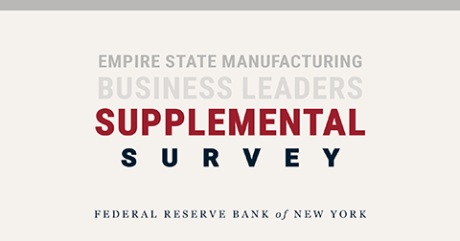
Shortly after the recovery from the pandemic recession began, the U.S. economy entered a period of high inflation as surging demand, severe supply disruptions, and worker shortages combined to create large imbalances and inflationary pressures in the economy. More recently, however, inflationary pressures have been moderating. Indeed, the inflation rate as measured by the consumer price index (CPI) has come down from its recent peak of 9.1 percent in the summer of 2022 to 3.1 percent at the start of 2024. Have inflationary pressures also moderated for local businesses in the New York–Northern New Jersey region? The New York Fed’s February business surveys asked firms about increases in their costs and prices. Results indicate that the pace of increase in costs, wages, and prices have all slowed considerably over the past year. Moreover, firms in the region expect cost and price increases, as well as the overall inflation rate, to moderate further in the year ahead.
Cost, Wage, and Price Increases Have All Slowed Considerably
While inflation remains higher than ideal, much progress has been made. CPI inflation has fallen 6 percentage points since June 2022, and inflation as measured by the producer price index has come down more than ten percentage points from its peak. Supplementary questions in the February Empire State Manufacturing Survey and Business Leaders Survey focused on recent and expected changes in firms’ costs, wages, and selling prices. Results reveal that regional firms are seeing the pace of increase in their costs and prices slowing, consistent with patterns in overall inflation.
Indeed, as the chart below shows, while firms reported an average cost increase of 11 to 13 percent for 2022, such increases fell to 5 to 6 percent over the past year. Wage increases in 2022 were about 5.5 percent for service firms and 6.4 percent for manufacturers, and slowed to 4.3 percent and 5.3 percent, respectively, over the past twelve months. A similar pattern was observed for selling price increases, which fell from an average of 7.3 percent among service firms and 9.5 percent among manufacturers in 2022 to an average of 5.3 percent and 3.2 percent, respectively, this past year. Firms expect all three measures to moderate further over the next twelve months: for both types of firms, cost increases are expected to slow to around 3.6 percent, wage increases are expected to slow to 3.8 percent, and selling price increases expected to fall to around 3 percent.
Firms See Inflationary Pressures Moderating
Service Firms
Percent
Manufacturing Firms
Percent
Source: New York Fed February 2024 Supplemental Survey.
Inflation Expectations Are Also Moderating
Firms were also asked about their expectations for the overall inflation rate in the economy over the next year, a question which was also posed in surveys conducted in May and December of 2022. As the chart below shows, firms’ median year-ahead inflation expectations have come down noticeably. In May 2022, when inflationary pressures were near their peak, firms’ year-ahead inflation expectations, as measured by the CPI, were above 6 percent, though longer-run inflation expectations remained anchored. By the end of 2022, year-ahead inflation expectations had already come down slightly. In our most recent survey, after more than a year of moderating inflationary pressures, the overall inflation rate is now expected to be around 3 percent over the next year, the same as what consumers are expecting according to the New York Fed’s latest Survey of Consumer Expectations.
Firms’ Inflation Expectations Continue to Moderate
Percent
Note: Bar charts plot median year-ahead inflation expectations.
Final Thoughts
All in all, our February business surveys point to ongoing moderation in inflationary pressures. This is welcome news: though inflation remains elevated, much progress has been made over the past year and more progress is expected in the year ahead. Still, this is an issue we will be tracking closely. Visit our Regional Economy website to stay up to date on economic conditions in the region.

Jaison R. Abel is the head of Urban and Regional Studies in the Federal Reserve Bank of New York’s Research and Statistics Group.

Richard Deitz is an economic research advisor in Urban and Regional Studies in the Federal Reserve Bank of New York’s Research and Statistics Group.
How to cite this post:
Jaison R. Abel and Richard Deitz, “Businesses See Inflationary Pressures Moderating,” Federal Reserve Bank of New York Liberty Street Economics, February 21, 2024, https://libertystreeteconomics.newyorkfed.org/2024/02/businesses-see-inflationary-pressures-moderating/.
Disclaimer
The views expressed in this post are those of the author(s) and do not necessarily reflect the position of the Federal Reserve Bank of New York or the Federal Reserve System. Any errors or omissions are the responsibility of the author(s).














 RSS Feed
RSS Feed Follow Liberty Street Economics
Follow Liberty Street Economics